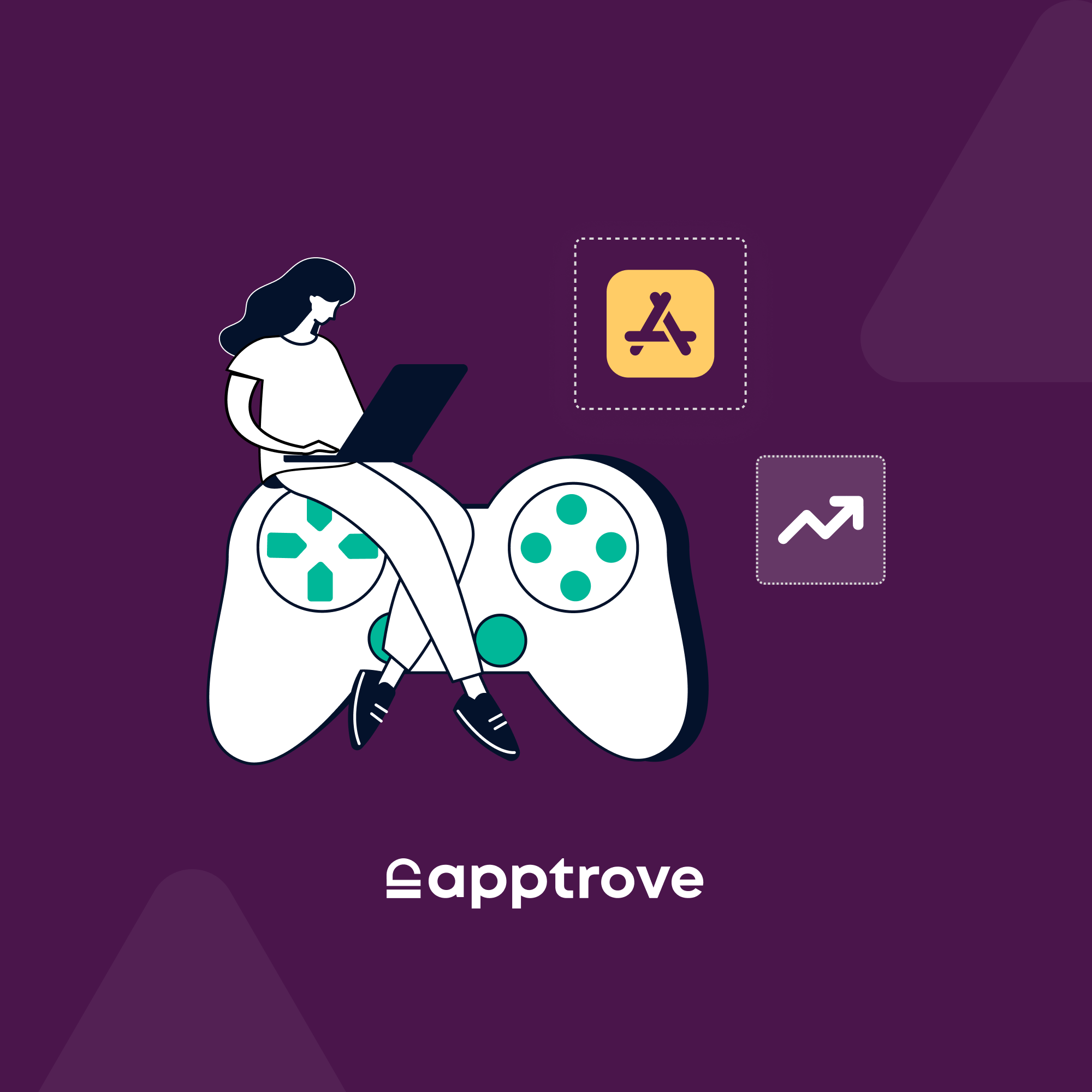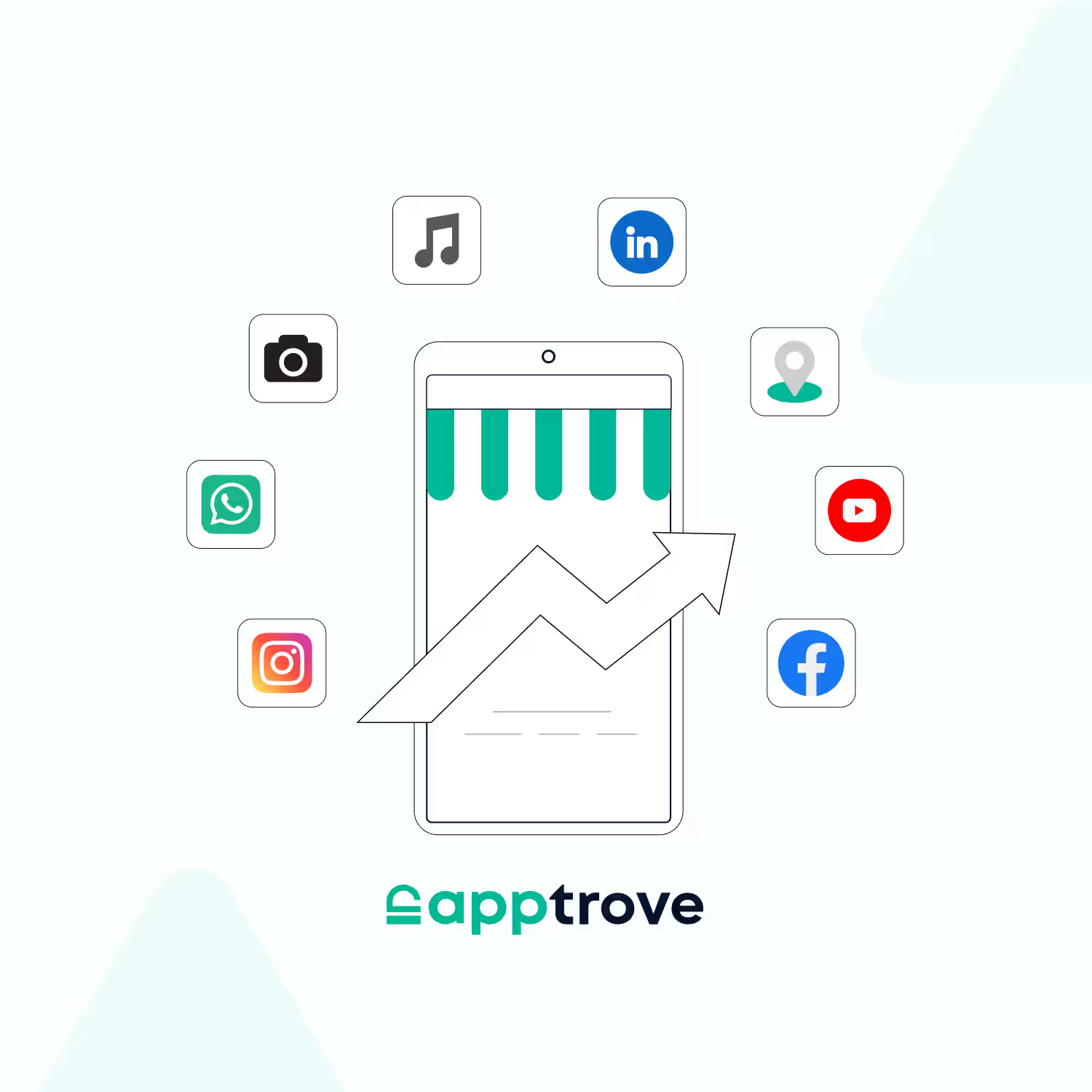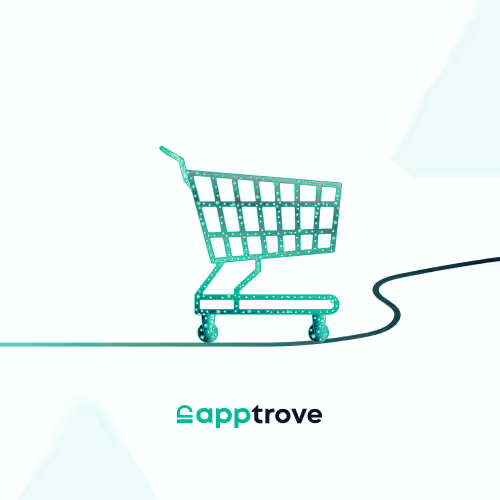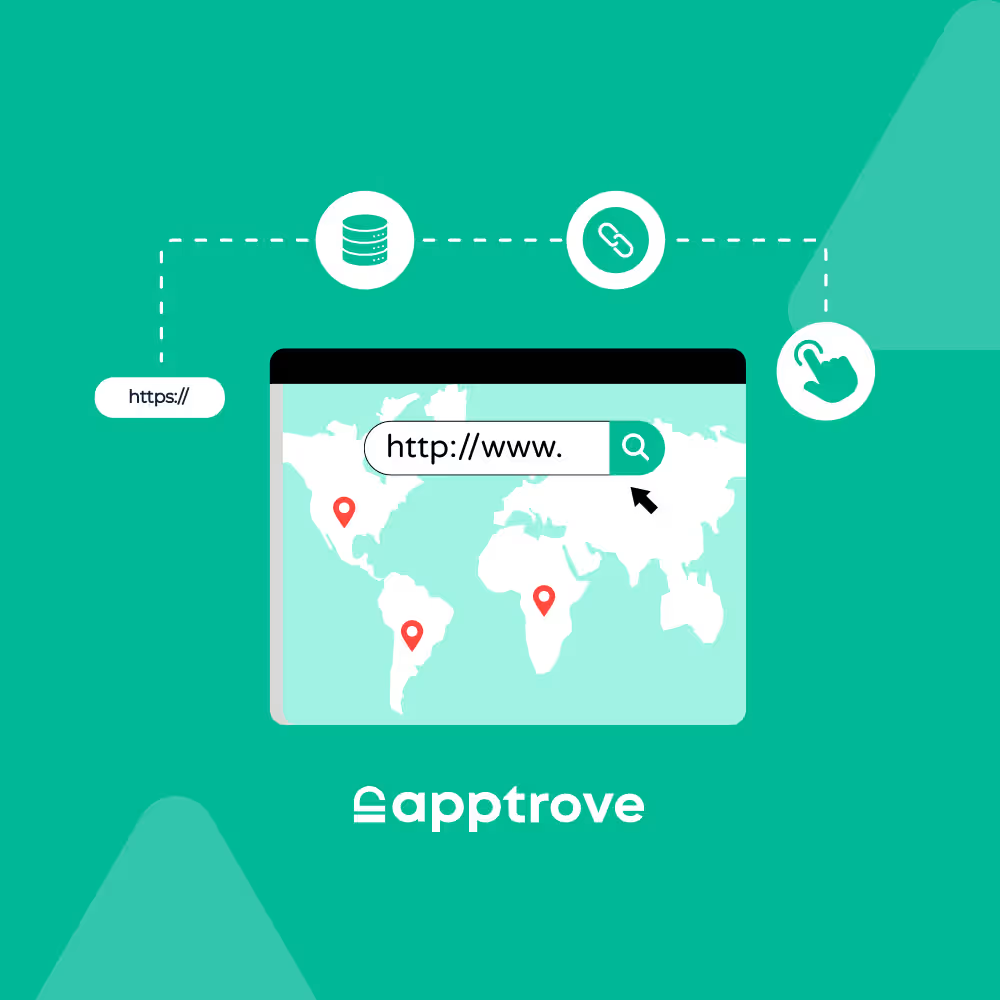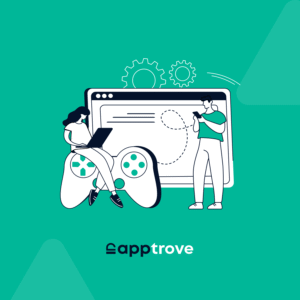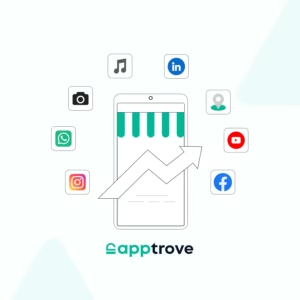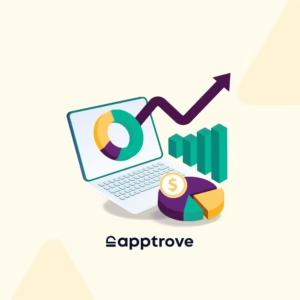Idle games have cracked the code on a paradox in a world that is fast-scrolling, frequently tapping and notifications pinging. They have players hooked without players needing to necessarily “play” it at all. That said, the downside is that idle games can fade just as quickly as they get popular. The App Store shelves are filled with abandoned idle simulators and forgotten clickers that had all the right mechanics but not the staying power.
So, the focus now is to understand how to make idle game that not only trends but also lasts. The one that scales effectively, monetizes correctly, and breeds loyal fans back to your game long after the initial hype has faded.
Idle games show approximately 18% stickiness, compared to just 10.5% for hyper-casual titles, which means more players returning daily versus leaving after a quick try.
To put that into perspective, the average mobile game across all genres in 2024 had Day-1 retention of around 26-28%, Day-7 retention close to 8%, and Day-30 retention below 3%. Idle titles and hybrids often outperform those benchmarks by keeping players engaged through well-paced loops and meta systems.
In this guide, we will lay out how to make an idle game. Covering everything from retention-first mechanisms and smart monetization models, to deep link usage, A/B testing, and using Apptrove for advanced in-game analytics, you’ll learn how to make an idle game that survives the trend cycle.
What You Need to Know About How to Make an Idle Game That’s Both Simple and Addictive
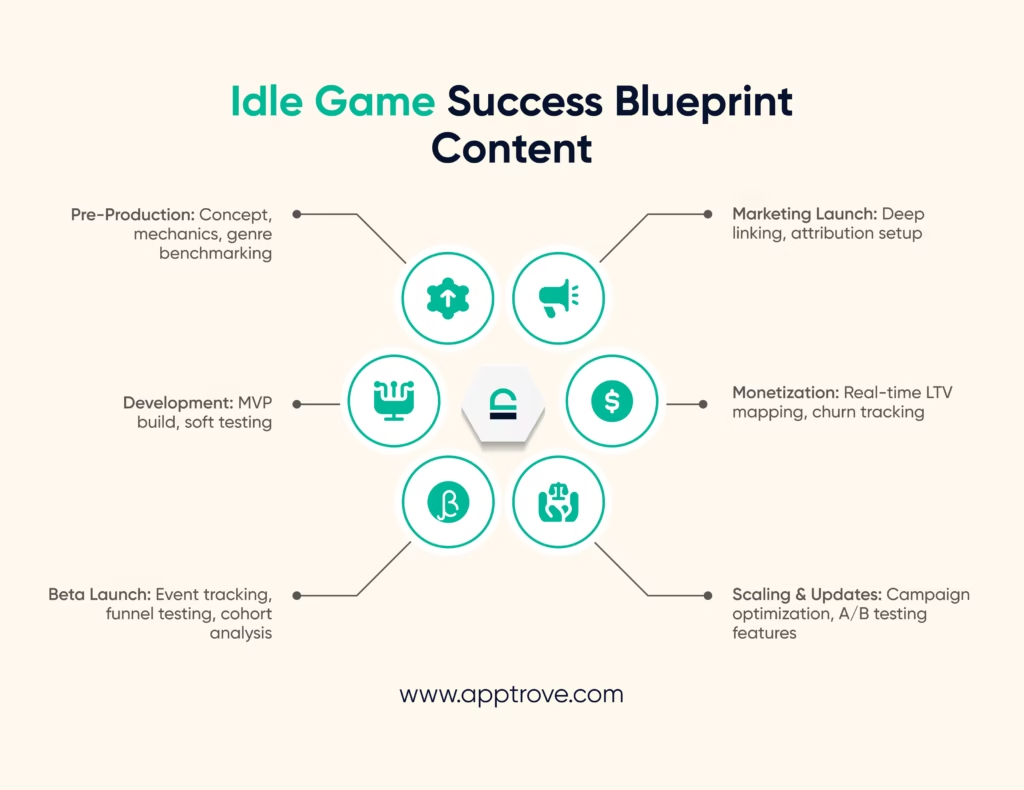
1. Understanding How to Make an Idle Game Work
Idle games or incremental games thrive on a core mechanic: progress without constant input. But the simplicity is deceptive. Behind the tap-and-wait formula lies a complex web of systems design, progression pacing, reward strategy, and retention loops.
The best-performing idle games tap into two distinct psychological rewards: the pleasure of watching progress unfold, and the anticipation of greater payoff with minimal effort. These games succeed not just because they’re easy to play, but because they create long-term engagement through compounding rewards and exponential growth arcs.
From a design standpoint, idle games lower the cognitive load for players. Unlike high-action titles, these games rely less on player skill and more on optimization strategy. That makes them accessible across demographics, from hypercasual players to lapsed gamers who crave low-pressure gameplay.
If you’re just stepping into idle game development, this foundational guide on idle games offers a deep dive into sub-genres, monetization frameworks, and player motivations.
But in this cluster guide, we’re going further. We’re unpacking what it really takes to build, scale, and monetize an idle game that won’t just see downloads, but will sustain LTV, virality, and store visibility in a saturated market.
2. Planning Core Gameplay Loops That Don’t Plateau
Idle games win or fail on the strength of their loops. And when we say “loop,” we’re not just talking about a single mechanic like tapping to earn coins. A successful idle game stitches together multiple feedback systems resource collection, progression milestones, upgrades, prestige resets, and automated gains into one seamless experience that feels like it’s always rewarding the player, even if they’re not online.
But designing these loops isn’t about throwing features together. It’s about pacing. The best idle games map out a progression curve that slows down just enough to nudge players toward upgrades, new currencies, or time skips, without making the wait feel punishing. A smart loop doesn’t just keep players engaged; it quietly teaches them how to optimize, strategize, and reinvest their gains.
Here’s where Apptrove’s audience, especially user acquisition teams and product marketers, needs to zoom in. The core loop directly impacts everything from tutorial completion to first-week retention and monetization. If your loop is too short, players burn out. Too long, and they churn before the first dopamine hit.
In practice, games that deliver well-paced loops tend to see Day 7 retention of 10-15%, in contrast to the 8% typical benchmark. What you want is a loop that scales, with layers of automation and unlocks that keep engagement climbing even as the player’s actual interaction dips.
A few game design principles that help:
- Introduce one variable at a time (new currency, automation, or prestige) to prevent overwhelm.
- Start with fast feedback (e.g., earnings per tap) and gradually introduce passive income to drive habit.
- Design your UI so that the player can see progress, like bars filling, coins piling, things unlocking. Idle games are visual metaphors for momentum.
These loops aren’t just retention tools. They’re also goldmines for behavioral analytics. With Apptrove, you can track which loops retain users best, when they drop off, and which upgrades drive revenue spikes. This kind of insight isn’t just valuable, it’s foundational to scaling idle games in competitive categories.
3. Building a Resource Economy That Feels Satisfying, Not Stingy
At the heart of every great idle game is a well-balanced resource economy. The dopamine isn’t just in collecting coins or gems, it’s in feeling like your effort (or time) is consistently rewarded, even in small, incremental ways. That satisfaction is not accidental, it’s designed.
When your game’s economy works, players stay in the loop longer. They feel smart for making the right upgrade, excited when automation kicks in, and motivated to reinvest when a prestige reset appears. But if your economy is too tight or too generous, it breaks the illusion of progress. Either they hit a wall and bounce, or they max out so quickly there’s nothing left to chase.
This is where idle games really flex their genre. You’re not just balancing one currency, you’re building layered economies: soft currencies (like gold or energy), hard currencies (premium gems), and sometimes even meta-currencies earned through resets or prestige. The trick is timing their introduction and making them feel interconnected.
A good idle economy:
- Rewards exponential growth (e.g., a single upgrade giving 10x returns).
- Introduces diminishing returns smartly to slow progress without making it painful.
- Uses scarcity and abundance in waves, so players feel both flush and hungry at different points.
For game marketers and product teams using Apptrove, this is where analytics become your superpower. By instrumenting resource flows, you can pinpoint where players are hoarding, abandoning, or converting. Are users exiting the game right before a major upgrade? That’s a sign the economy might need tuning. Are players watching rewarded ads instead of making IAPs? Time to test alternate value exchanges.
With Apptrove’s real-time behavioral data and retention analysis tools, you can map resource sinks and sources directly to user journeys. You’ll understand why players engage with your monetization systems, not just when.
In a genre where satisfaction is currency, the right economy doesn’t just fuel gameplay, it drives lifetime value.
4. Designing a UI That Guides, Not Overwhelms
Idle games are deceptively simple. Tap, upgrade, repeat. But under the hood, there’s a ton going on: multiple currencies, parallel progression tracks, time-based unlocks, automation layers, and sometimes even narrative arcs. Without a clear, intuitive UI, this beautiful complexity can quickly spiral into confusion and churn.
Your UI isn’t just a functional necessity. It’s the player’s compass. A well-designed interface teaches the core loop, reinforces rewards, and celebrates progress. In idle games, where players often return after hours (or days) away, the UI must make it easy to re-engage immediately, no tutorial needed.
Smart idle UIs follow three core principles:
- Prioritize the Loop
The core gameplay loop (tap to earn, spend to upgrade, repeat) should be front and center. No unnecessary animations, no distracting submenus. If a player opens your game and doesn’t know where to tap first, you’ve lost them. - Show, Don’t Hide Progression
Use progress bars, milestones, and floating number tickers to give visual feedback. Even passive play should feel active. If players return to a wall of static numbers or hidden gains, it kills the momentum. - Introduce Complexity Gradually
The best idle games layer in systems: auto-collectors, prestige mechanics, time boosts, limited-time events. But dump all that in the first 10 minutes and new players will bail. Use UI to unlock complexity progressively, visually graying out advanced tabs or using tooltip-style onboarding when new systems unlock.
For Apptrove users, this stage is a goldmine for testing. UI/UX changes are some of the easiest A/B experiments to run and some of the most impactful. Through in-app behavior tracking, you can see if players are reaching critical milestones, navigating upgrade menus efficiently, or dropping off at confusing UI junctions.
One popular idle title using Apptrove ran a UI split test where they moved the prestige button from a small icon in the top-right to a central animated badge once a player qualified. That single change improved prestige engagement by over 28%, translating into more long-term retention and monetization.
Idle games thrive on smooth mental models. With thoughtful UI and strong behavioral insights from Apptrove, you’re not just building a game, you are building a habit.
5. Automation & Prestige: The Engine of Long-Term Engagement
Idle games live and die by how satisfying their automation feels. The joy of going from frantic tapping to effortless income is the dopamine loop players crave. And prestige mechanics like those “reset for bonus” systems turn that loop into an infinite spiral of progression.
But here’s the catch: badly timed automation or poorly balanced prestige systems can kill engagement. Either players automate too fast and get bored, or prestige too often and feel like they’re grinding in circles.
Let’s break it down:
Automation: Freeing the Player, Without Losing the Player
Early on, tapping feels fun. You’re earning fast, unlocking upgrades, watching numbers fly. But very quickly, players crave efficiency. They want collectors, managers, bots, and anything that lets them earn while AFK.
To keep this feeling rewarding:
- Pace automation unlocks with care. Too early, and players disengage. Too late, and they churn.
- Make automation feel earned. Let players work for it, upgrade it, and feel smart for investing in it.
- Visually celebrate automation. Use animations, upgraded machines, or helper characters to make passive play feel active.
Think of automation as your game’s “retention insurance.” If players know they’ll come back to gains, they’ll return.
Prestige: Resetting Without Regret
Prestige (or reincarnation, ascension, etc.) is the core long-term loop in most idle games. Players hit a soft cap, reset their progress, and in return, gain a permanent bonus.
When done right, prestige systems create endless replayability. When done wrong, they feel like punishment.
Make prestige work by:
- Timing it right. A good prestige point feels like a plateau: progress slows noticeably, and the bonus feels worth the reset.
- Making it impactful. Double earnings, unlock new tiers, reveal hidden content, prestige should feel like opening a door, not restarting a grind.
- Tying it to emotion. Players should feel clever, powerful, or even a little smug for prestiging. Reinforce that with visual flair or celebratory UI.
Here’s where Apptrove becomes essential. Through real-time event tracking and funnel analytics, you can monitor when players unlock automation, how long they wait to use it, and where they drop off before or after prestige
One idle game tracked prestige hesitation using Apptrove and discovered a massive drop-off just before the prestige button was unlocked. Players didn’t understand what prestige would do. A quick tooltip and animated preview fixed it, leading to a 19% uplift in retention past Day 7.
Automation builds trust. Prestige builds addiction. When tuned right, these systems turn idle players into lifetime users.
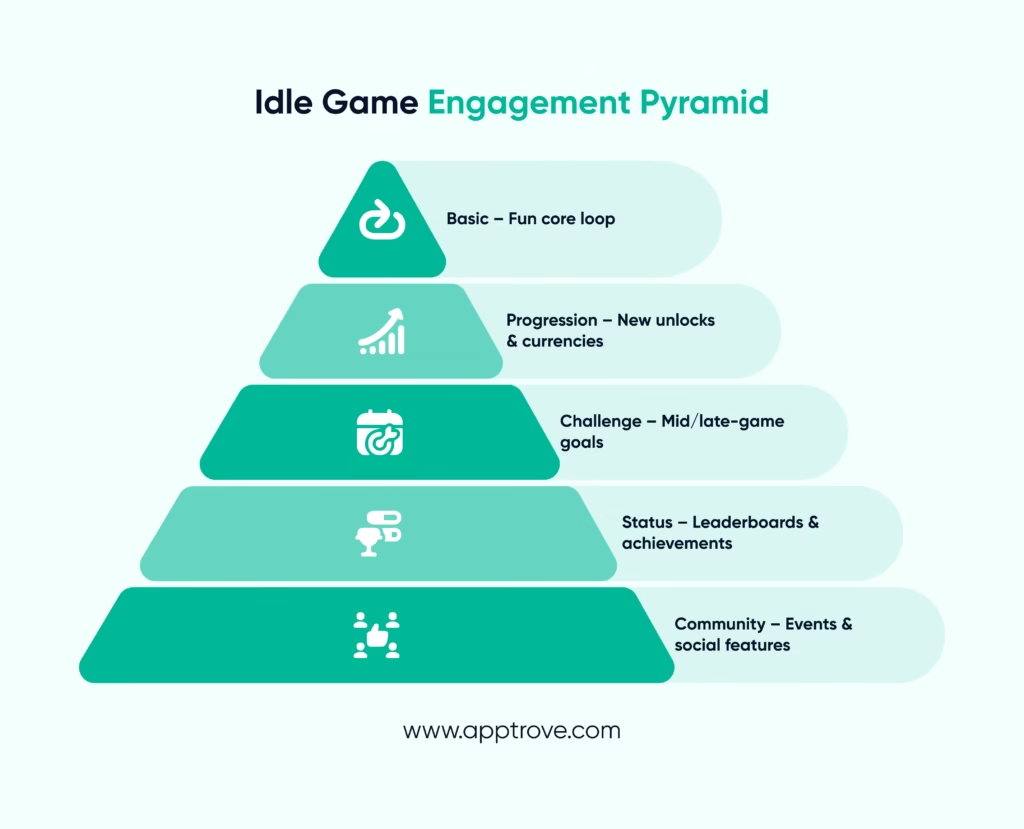
Designing for Longevity: How to Make Your Idle Game Stick
Creating a popular idle game isn’t the same as creating a sustainable one. As the App Store cycles through trends, from hyper-casual to hybrid casual and now back to simulation-heavy games, longevity is what separates a fleeting success from a long-term revenue driver. Designing for longevity requires thinking beyond the core gameplay loop and looking at systemic depth, platform shifts, and most importantly, player motivation.
Let’s start with player psychology. The best idle games don’t just reward waiting, they reward planning. They let players feel smart, productive, and occasionally even superior. When someone invests time in your game (whether actively or passively), you must make sure that investment feels worthwhile. This means designing layered systems where choices matter, even if they’re made once every few days.
Meta progression is a major tool here. Think of mechanics like prestige, reincarnation, skill trees, or alternate dimensions. These are all tried-and-tested ways to encourage replayability. But the key is pacing. If you push the prestige button too soon, it becomes meaningless. If you wait too long, players churn. Balance is everything.
Another overlooked ingredient is seasonality. Introducing time-bound updates like events, limited-time challenges, or holiday-themed content gives your game new life every few weeks. It keeps returning players engaged while attracting new ones through featured placements in stores or word-of-mouth virality.
Lastly, don’t ignore how platform evolution affects design. With Android and iOS constantly introducing performance, UX, and privacy updates, idle games must be flexible. What works today might need a technical revamp tomorrow. That’s where Apptrove comes in by helping game studios track real-time behavioral insights, retention dips, and in-app interaction patterns, we help you evolve before your game hits stagnation.
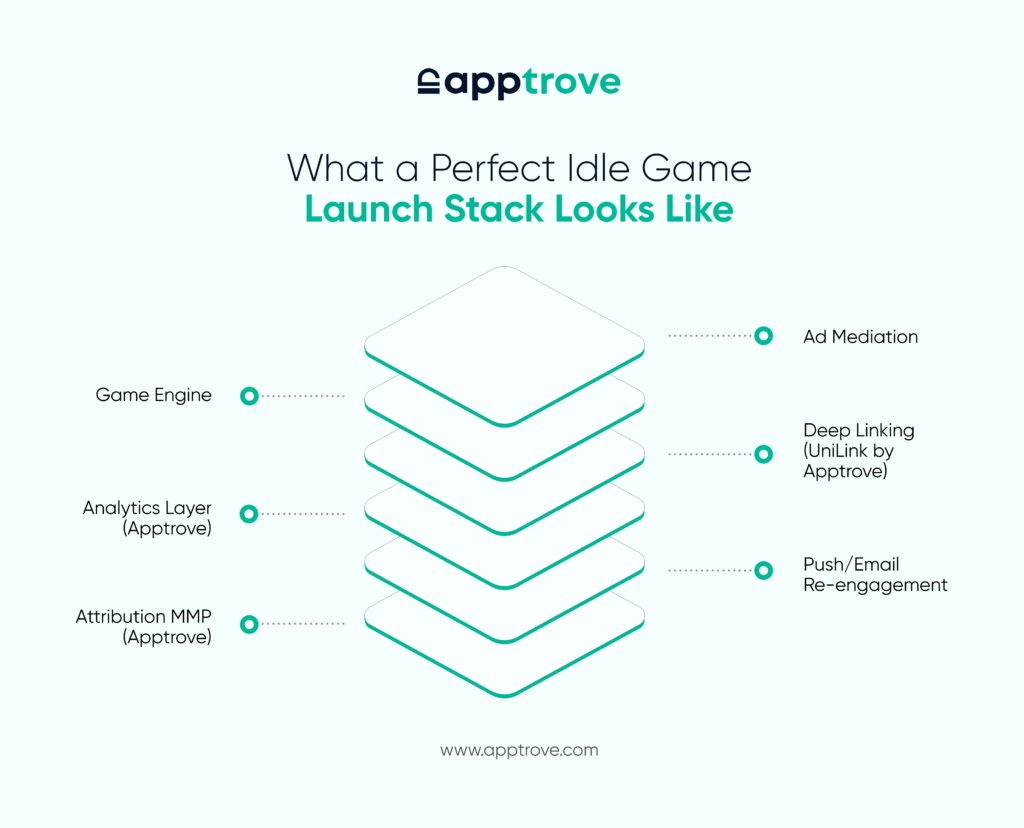
How to Make an Idle Game That Monetizes Sustainably
Idle games operate in a unique sweet spot when it comes to monetization. Unlike twitch-heavy action games or story-driven RPGs, idle titles are built for long engagement windows and casual interactions. That opens up monetization opportunities that are subtle, frequent, and often more effective than aggressive in-your-face mechanics. But that doesn’t mean you can take a spray-and-pray approach to monetization. You have to be deliberate.
There are three primary levers that idle game developers pull: in-app purchases (IAPs), ads, and hybrid monetization. The trick is to understand your player segments deeply and tailor value exchanges accordingly.
IAPs in idle games tend to perform best when they offer time compression. Players aren’t necessarily buying a new weapon or skin; they’re buying progress. Speed boosts, auto-collectors, prestige shortcuts these are high-value assets in the idle economy. The key is to avoid making the game feel like it’s pay-to-progress. Players should want to spend, not need to.
Ads, particularly rewarded ads, can be a goldmine, when used wisely. Idle games offer the perfect context for opt-in video ads: players are already in a passive mindset, so watching a 30-second ad for a double income multiplier feels fair. But frequency and timing matter. If ads interrupt gameplay or if rewards feel underwhelming, your retention takes a hit.
This is where hybrid monetization excels. The best-performing idle games combine ads and IAPs by giving players multiple paths to the same benefit. If you want that golden auto-collector, you can earn it in 2 hours, buy it for $2, or watch 4 ads. This gives players a sense of control, increases engagement, and boosts your overall ARPDAU (average revenue per daily active user).
But to make all of this work, you need deep visibility into your player cohorts, who’s watching ads, who’s spending, who’s churning right before monetizing. Apptrove helps idle game developers track and attribute these behaviors in real time. With our analytics tools, you don’t just guess what works, you test, validate, and optimize.
The final piece of the puzzle is testing monetization strategies across geographies, devices, and acquisition channels. What works in Tier 1 markets might fail in emerging economies. With Apptrove, you can break down monetization performance across these dimensions and scale what works where it works.
How to Make an Idle Game That Nails Retention from Day One
Idle games might be “casual,” but acquiring users at scale is anything but. The space is crowded, CPIs are volatile, and even the most promising creative can burn out in days. To scale sustainably, you need a full-funnel UA strategy that’s flexible, data-informed, and built for long-term payback, not just a Day 0 spike.
Start with channel diversification. Meta and Google may be your foundation, but they’re not enough. TikTok and YouTube Shorts are goldmines for idle games because they naturally showcase progress, transformation, and “before/after” gameplay loops that are ideal for snackable, satisfying content. Influencer collabs and UGC-style creatives amplify this even further, especially if you showcase funny upgrade moments or viral progression chains.
But performance doesn’t just come from the right platforms, it comes from the right signals. Idle games have long LTV curves, so early signals like installs and clicks don’t paint the full picture. What matters is who actually sticks around. That’s where event-based optimization comes in. Instead of optimizing for installs, top idle game marketers are optimizing for milestones: first prestige, first shop unlock, first IAP. These events correlate better with long-term value.
Instead of optimizing for installs, top idle game marketers are optimizing for milestones: first prestige, first shop unlock, first IAP. These events correlate better with long-term value. Top-performing mobile games set a high bar: Day-1 retention in the 35-40% range, Day-7 between 10-15%, and Day-30 from 5-10%. These are strong benchmarks to test your onboarding, loop pacing, and monetization design against.
This kind of optimization requires a robust attribution layer. That’s where Apptrove fits in. We help you go beyond SKAN-level reporting and tie user actions like completing onboarding or watching 3 rewarded ads, back to the original campaign, even across re-engagements. This is crucial when you’re running burst campaigns or experimenting with new geo expansions.
Another lever for sustainable UA is Creative iteration. Idle games thrive on novelty, with new stages, new mechanics, new skins. Your ads should reflect that. Don’t just show the basic gameplay loop, show the 1-to-1000x transformation. Show ridiculous upgrades and the dopamine kick of offline earnings. And test everything from copy hooks to reward structures.
Ultimately, scaling sustainably means building a loop. Acquisition feeds data, data feeds insight, insight feeds creative and audience optimization. And Apptrove helps you close that loop by giving you a single dashboard that connects campaign spend to revenue events, LTV, churn, and reactivation.
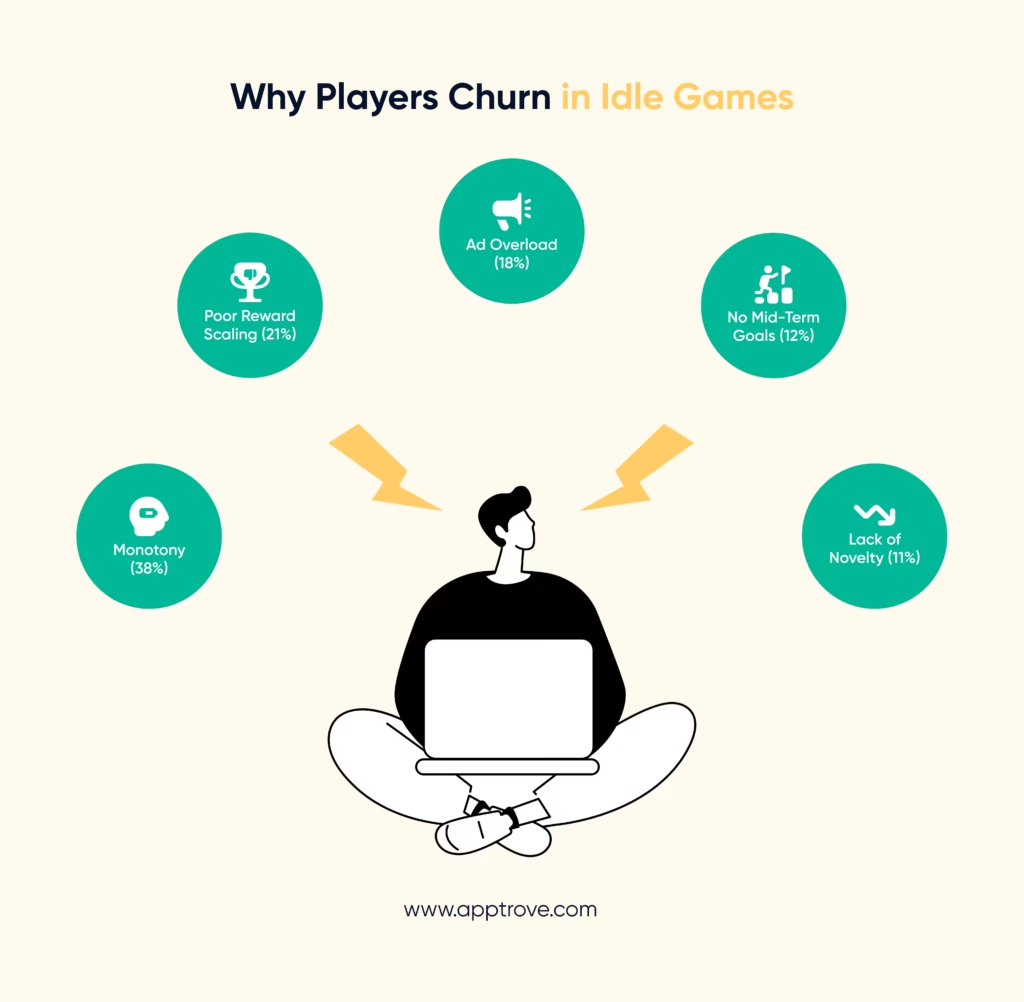
Designing Core Gameplay Loops That Work and Scale
At the heart of every idle game lies a loop. But not just any loop, it is a well-crafted, psychologically satisfying one. The magic of idle games is that they simulate progress even when the user is offline. Your job as a game developer or marketer isn’t to make the player grind; it’s to make them want to come back and watch the progress unfold.
A great gameplay loop is like a perfectly tuned machine: it generates rewards at just the right pace, triggers dopamine hits without feeling manipulative, and gives players a reason to reinvest, either emotionally or monetarily. In most successful idle games, the loop is simple at first: tap to earn, spend to automate, watch numbers rise. But behind that simplicity is a progression system that’s quietly doing the heavy lifting.
Successful core loops balance effort with automation. At the beginning, players are encouraged to interact heavily, tapping, upgrading, unlocking. Over time, automation features reduce the need for manual input while introducing more complex systems like prestige resets, time-limited events, or unlockable currencies that keep the loop from becoming stale.
As seen in high-performing idle games, the progression mechanics evolve without ever abandoning that core promise: log in, get rewarded, repeat. And this is exactly where Apptrove can step in for growth-oriented game developers. Our mobile game analytics platform helps you identify where your players are dropping off in the loop, what drives re-engagement, and how to tweak your event design to improve retention.
Without a scalable core loop, idle games risk becoming background noise in the app ecosystem. But with one they become habit-forming and revenue-generating machines.
Balancing Progression and Player Motivation: The Invisible Hand Behind Engagement
Progression in idle games isn’t just about speeding up numbers or unlocking new items. It’s about delivering a sense of forward momentum that feels both earned and enticing. The goal isn’t to overwhelm players with complexity, but to ensure that every session, no matter how short, feels meaningful.
This is where many idle games shine: they offer a steady drip of rewards that trigger a feeling of accomplishment without demanding intense effort. From a product design perspective, this is about managing pacing.
In early gameplay, progression should feel fast and generous. This is your hook phase, where players are forming habits. Later, you can introduce longer-term goals like prestige systems, tiered upgrades, or offline multipliers. These features extend the game’s lifespan and give advanced players a reason to keep returning.
What separates a sticky idle game from a forgettable one is how well it aligns its progression curve with player motivation. And that’s something you can’t just feel, you need to measure it. With Apptrove, you can dig deep into progression analytics like where users plateau, when do they stop upgrading, and if monetization features helping or hurting your game flow.
Progression systems must constantly be tuned, not only to maintain user interest but to drive monetization opportunities like IAP bundles, ad boosters, or season passes. A/B testing through Apptrove’s data engine lets you compare different upgrade paths, reward intervals, or economy adjustments, so your game grows with your audience, not against it.
Ultimately, balancing progression is about honoring the player’s time. Give them the sense that they’re always moving forward, even if they’re technically standing still, and you’ll create a game they’ll come back to for weeks, not just hours.
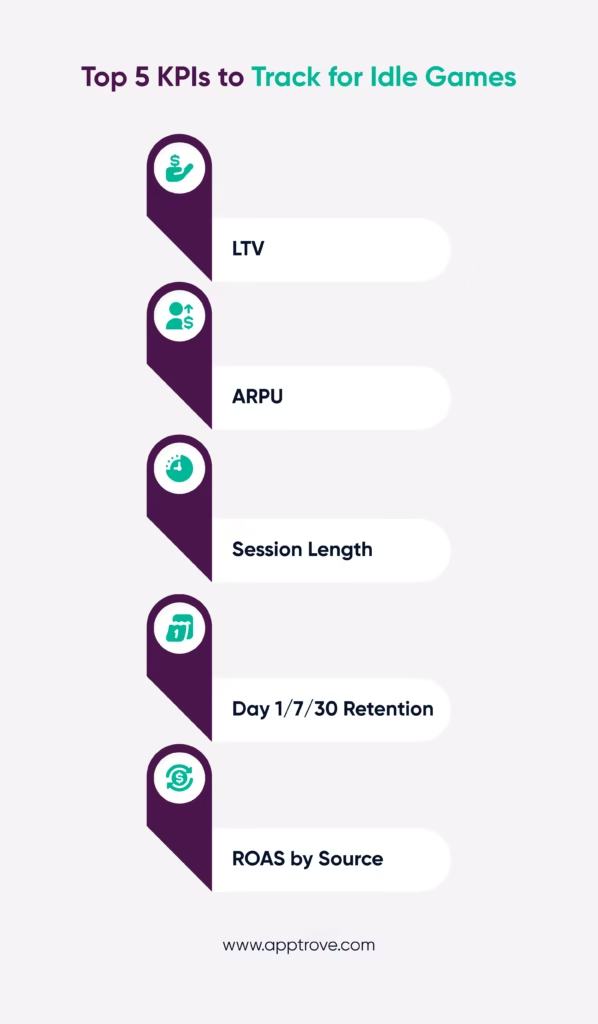
Designing for Virality: Why Your Idle Game Needs Built-In Share Triggers
Idle games don’t go viral by accident. They go viral because they’re designed with moments worth sharing and mechanisms that make sharing frictionless. For mobile idle games especially, virality isn’t just a nice-to-have growth lever. It’s one of the few scalable, cost-effective acquisition strategies left in a post-ATT world.
But let’s be clear, not all share buttons are created equal. A generic “share your progress” CTA buried in a menu won’t cut it. Instead, virality needs to be native to the game loop. Think milestone moments that feel epic: hitting 1 trillion coins, unlocking a rare upgrade, or breaking a global leaderboard. These are the emotional highs where players want to show off, and that’s when your game needs to prompt them.
Apptrove helps you track exactly when and where those share-worthy moments happen. Through real-time event tracking, you can identify engagement spikes, build behavioral segments, and push smart prompts at the right moments. And when you combine that with deferred deep linking via Apptrove’s UniLink, you can turn each share into a personalized invitation, not just a generic app link.
Referral loops are especially effective in idle games because of their low barrier to entry. Players don’t need to commit 30 minutes to onboard. A friend’s invite can drop them right into the fun, especially if the link comes with a small bonus, an exclusive boost, a limited-time cosmetic, or early access to a new feature.
This blend of behavioral insight and smart tech turns your players into your best marketers. And unlike ad budgets, this loop compounds. The more players you bring in, the more chances you have to trigger another round of shares. With Apptrove, you can monitor, optimize, and scale this loop, making virality not just a possibility, but a measurable, repeatable outcome.
